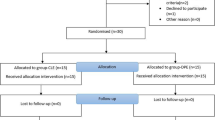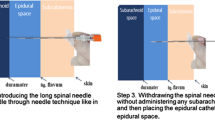Abstract
Dural puncture epidural (DPE) technique is a modification of the conventional epidural (EP) technique in that the dura is intentionally punctured with a spinal needle but without any spinal injection. This meta-analysis aimed to evaluate the benefits and risks associated with the DPE technique for labor analgesia. Randomized trials comparing DPE analgesia with EP analgesia for labor pain relief were systematically searched in the database of Medline, Embase, Cochrane Controlled Trials Register, Web of Science, and China Biology Medicine till 1st August 2021. The primary outcome was the percentage of patients with satisfactory pain relief following DPE or EP analgesia, which was defined as visual analog scale (VAS) pain scores ≤ 3/10 (or 30/100) measured 10 min and 20 min after initiation of labor analgesia. Totally ten trials with 1099 patients were included in this review. DPE technique increased the percentage of patients with VAS pain score ≤ 3/10 (or 30/100) both at 10 min (RR 1.43; 95% CI 1.17, 1.74; p < 0.001; I2 = 0%) and 20 min (RR 1.13; 95% CI 1.04, 1.22; p = 0.005; I2 = 0%) after labor analgesia. No adverse event was found with DPE analgesia. We conclude that compared with EP analgesia, DPE analgesia is beneficial for labor pain relief by shortening the time to achieve satisfactory pain control. Meanwhile, DPE analgesia is not associated with increased adverse maternal/fetal events.








Similar content being viewed by others
References
Simmons SW, Taghizadeh N, Dennis AT, Hughes D, Cyna AM. Combined spinal-epidural versus epidural analgesia in labour. Cochrane Database Syst Rev. 2012;10(10):cd003401.
Abrão KC, Francisco RPV, Miyadahira S, Cicarelli DD, Zugaib M. Elevation of uterine basal tone and fetal heart rate abnormalities after labor analgesia: a randomized controlled trial. Obstet Gynecol. 2009;113(1):41–7.
Hattler J, Klimek M, Rossaint R, Heesen M. The effect of combined spinal-epidural versus epidural analgesia in laboring women on nonreassuring fetal heart rate tracings: systematic review and meta-analysis. Anesth Analg. 2016;123(4):955–64.
Cappiello E, O’Rourke N, Segal S, Tsen LC. A randomized trial of dural puncture epidural technique compared with the standard epidural technique for labor analgesia. Anesth Analg. 2008;107(5):1646–51.
Gunaydin B, Erel S. How neuraxial labor analgesia differs by approach: dural puncture epidural as a novel option. J Anesth. 2019;33(1):125–30.
Thomas JA, Pan PH, Harris LC, Owen MD, D’Angelo R. Dural puncture with a 27-gauge Whitacre needle as part of a combined spinal-epidural technique does not improve labor epidural catheter function. Anesthesiology. 2005;103(5):1046–51.
Moher D, Liberati A, Tetzlaff J, Altman DG, Group P. Preferred reporting items for systematic reviews and meta-analyses: the PRISMA statement. BMJ. 2009;339:b2535.
Cumpston M, Li T, Page MJ, Chandler J, Welch VA, Higgins JP, Thomas J. Updated guidance for trusted systematic reviews: a new edition of the Cochrane Handbook for Systematic Reviews of Interventions. Cochrane Database Syst Rev. 2019;10: Ed000142.
Brown P, Brunnhuber K, Chalkidou K, Chalmers I, Clarke M, Fenton M, Forbes C, Glanville J, Hicks NJ, Moody J, Twaddle S, Timimi H, Young P. How to formulate research recommendations. BMJ. 2006;333(7572):804–6.
Luo D, Wan X, Liu J, Tong T. Optimally estimating the sample mean from the sample size, median, mid-range, and/or mid-quartile range. Stat Methods Med Res. 2018;27(6):1785–805.
Higgins JP, Altman DG, Gøtzsche PC, Jüni P, Moher D, Oxman AD, Savovic J, Schulz KF, Weeks L, Sterne JA. The Cochrane Collaboration’s tool for assessing risk of bias in randomised trials. BMJ. 2011;343:d5928.
Guyatt GH, Oxman AD, Kunz R, Falck-Ytter Y, Vist GE, Liberati A, Schünemann HJ. Going from evidence to recommendations. BMJ. 2008;336(7652):1049–51.
Guyatt G, Oxman AD, Akl EA, Kunz R, Vist G, Brozek J, Norris S, Falck-Ytter Y, Glasziou P, DeBeer H, Jaeschke R, Rind D, Meerpohl J, Dahm P, Schünemann HJ. GRADE guidelines: 1. Introduction-GRADE evidence profiles and summary of findings tables. J Clin Epidemiol. 2011;64(4):383–94.
Higgins JP, Thompson SG, Deeks JJ, Altman DG. Measuring inconsistency in meta-analyses. BMJ. 2003;327(7414):557–60.
Suzuki N, Koganemaru M, Onizuka S, Takasaki M. Dural puncture with a 26-gauge spinal needle affects spread of epidural anesthesia. Anesth Analg. 1996;82(5):1040–2.
Beaubien G, Drolet P, Girard M, Grenier Y. Patient-controlled epidural analgesia with fentanyl-bupivacaine: influence of prior dural puncture. Reg Anesth Pain Med. 2000;25(3):254–8.
Tsen LC, Cappiello E, O’Rourke N, Segal S. Dural puncture with a 25-gauge whiteacre needle enhances epidural labor analgesia. Anesthesiology. 2007;106(Suppl 1):67.
Chau A, Bibbo C, Huang CC, Elterman KG, Cappiello EC, Robinson JN, Tsen LC. Dural puncture epidural technique improves labor analgesia quality with fewer side effects compared with epidural and combined spinal epidural techniques: a randomized clinical trial. Anesth Analg. 2017;124(2):560–9.
Gupta D, Srirajakalidindi A, Soskin V. Dural puncture epidural analgesia is not superior to continuous labor epidural analgesia. Middle East J Anaesthesiol. 2013;22(3):309–16.
Lu Y, Cai J, Jin S, Wang C, Zhou Y, Hu M, Li J. Application of dural puncture epidural technique for labor analgesia [Chinese]. National Med J China. 2020;100(5):363–6.
Yadav P, Kumari I, Narang A, Yadav P, Kumari I, Baser N, Bedi V, Dindor B. Comparison of dural puncture epidural technique versus conventional epidural technique for labor analgesia in primigravida. J Obstet Anaesth Crit Care. 2018;8:24–8.
Song Y, Du W, Zhou S, Zhou Y, Yu Y, Xu Z, Liu Z. Effect of dural puncture epidural technique combined with programmed intermittent epidural bolus on labor analgesia onset and maintenance: a randomized controlled trial. Anesth Analg. 2021;132(4):971–8.
Wang J, Zhang L, Zheng L, Xiao P, Wang Y, Zhang L, Zhou M. A randomized trial of the dural puncture epidural technique combined with programmed intermittent epidural boluses for labor analgesia. Ann Palliat Med. 2021;10(1):404–14.
Wilson SH, Wolf BJ, Bingham K, Scotland QS, Fox JM, Woltz EM, Hebbar L. Labor analgesia onset with dural puncture epidural versus traditional epidural using a 26-gauge whitacre needle and 0.125% bupivacaine bolus: a randomized clinical trial. Anesth Analg. 2018;126(2):545–51.
Bakhet WZ. A randomized comparison of epidural, dural puncture epidural, and combined spinal-epidural without intrathecal opioids for labor analgesia. J Anaesthesiol Clin Pharmacol. 2021;37(2):231–6.
Heesen M, Rijs K, Rossaint R, Klimek M. Dural puncture epidural versus conventional epidural block for labor analgesia: a systematic review of randomized controlled trials. Int J Obstet Anesth. 2019;40:24–31.
Layera S, Bravo D, Aliste J, Tran DQ. A systematic review of DURAL puncture epidural analgesia for labor. J Clin Anesth. 2019;53:5–10.
Vartis A, Collier CB, Gatt SP. Potential intrathecal leakage of solutions injected into the epidural space following combined spinal epidural anaesthesia. Anaesth Intensive Care. 1998;26(3):256–61.
Leach A, Smith GB. Subarachnoid spread of epidural local anaesthetic following dural puncture. Anaesthesia. 1988;43(8):671–4.
Bernards CM, Kopacz DJ, Michel MZ. Effect of needle puncture on morphine and lidocaine flux through the spinal meninges of the monkey in vitro. Implications for combined spinal-epidural anesthesia. Anesthesiology. 1994;80(4):853–8.
Swenson JD, Wisniewski M, McJames S, Ashburn MA, Pace NL. The effect of prior dural puncture on cisternal cerebrospinal fluid morphine concentrations in sheep after administration of lumbar epidural morphine. Anesth Analg. 1996;83(3):523–5.
Contreras F, Morales J, Bravo D, Layera S, Jara Á, Riaño C, Pizarro R, De La Fuente N, Aliste J, Finlayson RJ, Tran DQ. Dural puncture epidural analgesia for labor: a randomized comparison between 25-gauge and 27-gauge pencil point spinal needles. Reg Anesth Pain Med. 2019;44(7):750–3.
Capogna G, Camorcia M, Stirparo S, Farcomeni A. Programmed intermittent epidural bolus versus continuous epidural infusion for labor analgesia: the effects on maternal motor function and labor outcome. A randomized double-blind study in nulliparous women. Anesth Analg. 2011;113(4):826–31.
Wong CA, Ratliff JT, Sullivan JT, Scavone BM, Toledo P, McCarthy RJ. A randomized comparison of programmed intermittent epidural bolus with continuous epidural infusion for labor analgesia. Anesth Analg. 2006;102(3):904–9.
Hogan Q. Distribution of solution in the epidural space: examination by cryomicrotome section. Reg Anesth Pain Med. 2002;27(2):150–6.
Bernard JM, Le Roux D, Frouin J. Ropivacaine and fentanyl concentrations in patient-controlled epidural analgesia during labor: a volume-range study. Anesth Analg. 2003;97(6):1800–7.
Mishriky BM, Habib AS. Metoclopramide for nausea and vomiting prophylaxis during and after Caesarean delivery: a systematic review and meta-analysis. Br J Anaesth. 2012;108(3):374–83.
Klumpner TT, Lange EM, Ahmed HS, Fitzgerald PC, Wong CA, Toledo P. An in vitro evaluation of the pressure generated during programmed intermittent epidural bolus injection at varying infusion delivery speeds. J Clin Anesth. 2016;34:632–7.
Bodian CA, Freedman G, Hossain S, Eisenkraft JB, Beilin Y. The visual analog scale for pain: clinical significance in postoperative patients. Anesthesiology. 2001;95(6):1356–61.
Acknowledgements
The authors would like to thank Jing Wang, MD, Department of Anesthesiology, Fujian Maternity and Child Health Hospital, Affiliated Hospital of Fujian Medical University, Fuzhou, China and Yujie Song, MD, Department of Anesthesiology, Shanghai First Maternity and Infant Hospital, Tongji University School of Medicine, Shanghai, China for generously providing unpublished data. Finally, the great help from Lei Yang M.D., Department of Anesthesiology, West China Hospital, is highly appreciated.
Author information
Authors and Affiliations
Corresponding author
Additional information
Publisher's Note
Springer Nature remains neutral with regard to jurisdictional claims in published maps and institutional affiliations.
Supplementary Information
Below is the link to the electronic supplementary material.
About this article
Cite this article
Yin, H., Tong, X. & Huang, H. Dural puncture epidural versus conventional epidural analgesia for labor: a systematic review and meta-analysis of randomized controlled studies. J Anesth 36, 413–427 (2022). https://doi.org/10.1007/s00540-022-03061-8
Received:
Accepted:
Published:
Issue Date:
DOI: https://doi.org/10.1007/s00540-022-03061-8




